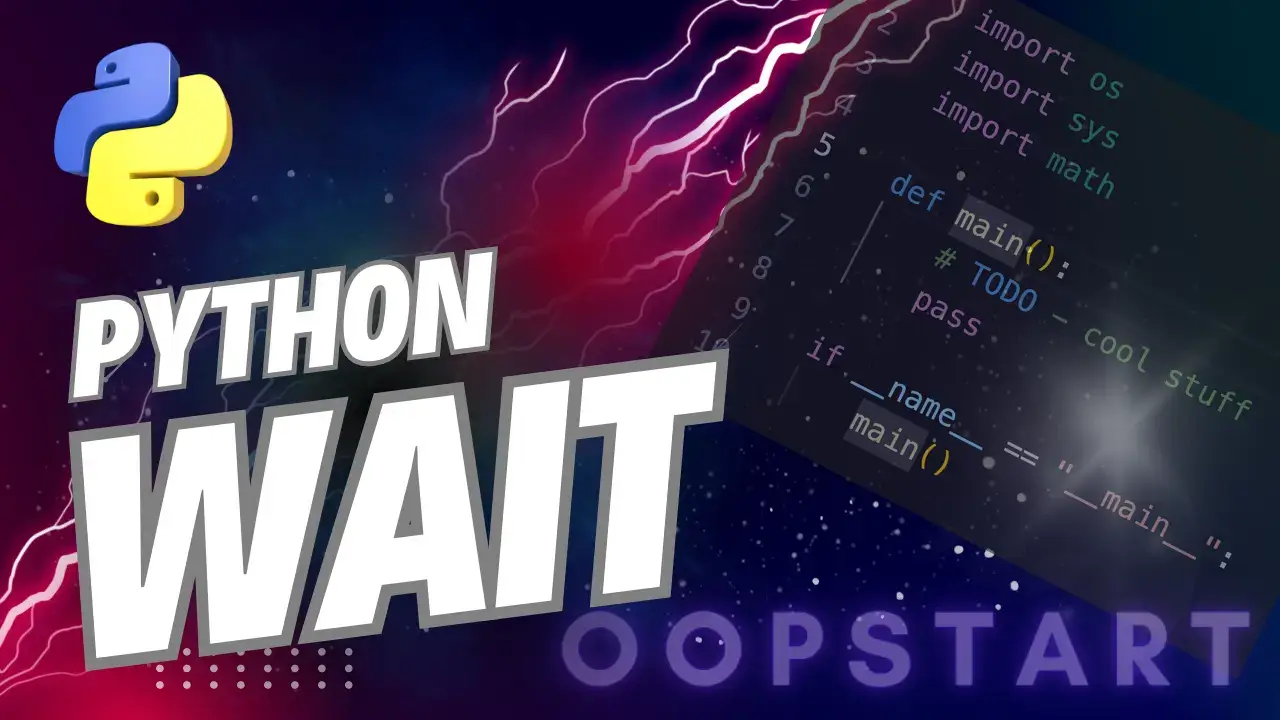Python Wait: Ultimate Guide
In Python programming, there are times when you need to pause or delay the execution of your code.
This is called “waiting,” and it’s essential in a variety of applications, like waiting for user input, pausing between steps in a loop, handling asynchronous operations, ensuring a web scraper doesn’t overload a server with too many requests, and any number of others.
By the end of this guide, you’ll have a solid understanding of your options for the best Python wait operation for your application.
Table of Contents
Why Use Waiting in Python?
Waiting or pausing in Python is useful for several scenarios:
- Delaying execution: Sometimes you need to pause a script for a specific amount of time (e.g., in games or simulations).
- Rate limiting: When sending requests to an API or server, you may need to wait between requests to avoid overloading the server or hitting rate limits.
- Asynchronous programming: In non-blocking code (such as network applications), waiting for data or an event to occur without blocking the main thread is essential.
- User interaction: Waiting for user input or a specific action before continuing the program.
Methods to Implement Wait in Python
1. Using time.sleep() for Basic Delays
The most common way to add a wait or delay in Python is to use the time.sleep() function from the time module. This function pauses the execution of the program for a specified number of seconds.
Syntax:
import time
time.sleep(seconds)
seconds: The number of seconds to pause the execution. This can be an integer or a floating-point number for more precise delays (e.g., 0.5 seconds for half a second).
Example: Basic Wait Using time.sleep()
import time
print("Waiting for 3 seconds...")
time.sleep(3)
print("Done waiting!")
In this example, the program pauses for 3 seconds before printing “Done waiting!”
Example: Wait with Fractional Seconds
import time
print("Waiting for 1.5 seconds...")
time.sleep(1.5)
print("Done waiting!")
Here, the program pauses for 1.5 seconds, demonstrating how you can use fractional seconds to create more precise delays.
2. Using asyncio.sleep() for Asynchronous Waiting
In asynchronous programming, you might need to wait without blocking the main thread. Python’s asyncio module provides the asyncio.sleep() function, which is similar to time.sleep() but designed for asynchronous code.
Syntax:
import asyncio
await asyncio.sleep(seconds)
seconds: The number of seconds to wait. This function must be used within anasyncfunction and called usingawait.
Example: Asynchronous Wait Using asyncio.sleep()
import asyncio
async def main():
print("Waiting for 2 seconds asynchronously...")
await asyncio.sleep(2)
print("Done waiting!")
# Run the async function
asyncio.run(main())
In this example, the program waits for 2 seconds asynchronously. Using asyncio.sleep() ensures that other tasks in the event loop can continue running while the program is paused.
3. Using input() to Wait for User Interaction
Another way to wait in Python is to use the input() function. This pauses the execution of the program until the user provides input, making it useful for interactive programs.
Example: Waiting for User Input
input("Press Enter to continue...")
In this example, the program pauses execution until the user presses Enter.
4. Using threading.Event() for More Advanced Waiting
For more complex scenarios, you can use the threading.Event() object to wait for an event to occur before continuing execution. This is useful in multithreaded programs where one thread needs to wait for another to complete a task.
Example: Waiting for an Event in Multithreaded Code
import threading
import time
event = threading.Event()
def worker():
print("Worker thread is waiting for the event...")
event.wait() # Wait for the event to be set
print("Event received, continuing...")
# Start the worker thread
thread = threading.Thread(target=worker)
thread.start()
# Simulate a delay in the main thread
time.sleep(2)
print("Setting the event in the main thread...")
event.set() # Set the event to allow the worker thread to continue
In this example, the worker thread waits for an event to be set by the main thread before continuing. The event.wait() method pauses the worker thread until event.set() is called in the main thread.
5. Using timeit.sleep() for Benchmarking with Waits
If you’re benchmarking or testing how long a piece of code takes to run with a delay, you can use the timeit module to measure the execution time of code that includes waiting.
Example: Benchmarking a Wait with timeit
import timeit
code_to_test = """
import time
time.sleep(2)
"""
execution_time = timeit.timeit(code_to_test, number=1)
print(f"Execution time: {execution_time} seconds")
This example measures how long it takes to execute a sleep call of 2 seconds.
Waiting in Loops
Waiting inside loops is a common use case in Python, especially when performing repeated tasks such as sending API requests, scraping websites, or polling for updates.
Example: Adding a Delay in a Loop
import time
for i in range(5):
print(f"Iteration {i}")
time.sleep(1) # Wait for 1 second between iterations
In this example, the program waits for 1 second between each iteration of the loop, ensuring that the process doesn’t run too quickly.
Waiting for Files or Resources
In some cases, you may need to wait until a specific resource becomes available, such as waiting for a file to exist before reading it. You can use a loop combined with time.sleep() to periodically check if the resource is available.
Example: Waiting for a File to Exist
import os
import time
file_path = "example.txt"
while not os.path.exists(file_path):
print(f"Waiting for {file_path} to be created...")
time.sleep(2)
print(f"{file_path} exists. Proceeding with file processing...")
In this example, the program waits until example.txt is created before continuing.
Best Practices for Waiting in Python
1. Avoid Blocking the Main Thread
If your program relies on user interaction, asynchronous tasks, or event-based programming, avoid blocking the main thread with time.sleep(). Instead, use non-blocking techniques like asyncio.sleep() or threading.Event() to allow other operations to continue.
2. Use Appropriate Wait Times
When adding delays in loops or network requests, ensure that the wait times are appropriate for your task. For instance, when scraping websites, too short a delay might cause you to get banned from the site, while too long a delay can make your script inefficient.
3. Limit the Use of Busy-Waiting
Busy-waiting, where the program continuously checks for a condition, can consume system resources unnecessarily. Instead of looping without pauses, add a small wait (time.sleep()) in each iteration to reduce CPU usage.
Example of Avoiding Busy-Waiting:
import time
while some_condition_is_not_met():
# Do some work
time.sleep(0.1) # Add a small wait to avoid overloading the CPU
4. Handle Exceptions in Asynchronous Code
When using asyncio.sleep() in asynchronous code, ensure that exceptions are handled properly to avoid hanging tasks. If your wait condition depends on external factors (e.g., waiting for a response from an API), include timeouts or exception handling mechanisms.
Common Pitfalls and How to Avoid Them
1. Blocking the Main Thread with time.sleep()
Using time.sleep() in the main thread of a GUI application or server can cause the interface or application to become unresponsive. In such cases, use asynchronous methods like asyncio.sleep() or threads to keep the application responsive.
2. Using time.sleep() in Asynchronous Code
In asynchronous programs, using time.sleep() will block the event loop and prevent other tasks from executing. Use asyncio.sleep() instead, which is designed for non-blocking waiting in asynchronous tasks.
3. Waiting Too Long in Loops
If you add long delays in loops (e.g., multiple seconds), it can make your program less efficient. Always use the shortest wait time that still accomplishes your goal.
Summary of Key Concepts
time.sleep()is the most common way to add a delay in Python and is useful for simple, synchronous waits.asyncio.sleep()is ideal for non-blocking asynchronous waits in modern Python programs.input()pauses the program until user input is received, making it useful for interactive scripts.threading.Event()provides advanced waiting functionality in multithreaded programs, allowing threads to wait for an event to occur.- Best practices include avoiding blocking the main thread, using appropriate wait times, and handling exceptions in asynchronous code.
Exercises
- Basic Wait: Write a Python program that prints a message, waits for 5 seconds, and then prints another message.
- Asynchronous Wait: Create an asynchronous Python script using
asynciothat runs two tasks concurrently, with each task waiting for a different amount of time. - Event-Based Wait: Implement a Python script that uses threads and
threading.Event()to coordinate a task between two threads.
By mastering the various ways to perform a Python wait, you’ll be able to implement more efficient and responsive programs, whether you’re handling user interactions, network requests, or asynchronous tasks. Let me know if you have further questions or need additional examples!
Check out our FREE Learn Python Programming Masterclass to hone your skills or learn from scratch.
The course covers everything from first principles to Graphical User Interfaces and Machine Learning
Here’s the official Python documentation on the Python wait function ‘sleep’ discussed above.
FAQ
Q1: Can I interrupt or cancel a time.sleep() call before it finishes?
A1: No, time.sleep() cannot be interrupted directly once it’s called, and the program will be blocked until the specified sleep time finishes. If you need the ability to interrupt or cancel a wait, consider using a multithreading approach where a thread can be stopped, or use asynchronous waiting with asyncio, which allows more flexibility in handling cancellation.
Q2: What’s the difference between time.sleep() and asyncio.sleep()?
A2:
time.sleep(): Blocks the entire program for the specified duration. It is useful for simple, synchronous waits but will stop all execution during the wait.asyncio.sleep(): Works in asynchronous programs and does not block other tasks from running during the wait. It’s ideal for non-blocking waits in asynchronous tasks, allowing the event loop to continue handling other coroutines.
Q3: Can I use time.sleep() inside a function that is marked as async?
A3: No, you should not use time.sleep() inside an async function, as it will block the event loop and prevent other asynchronous tasks from running. Instead, use await asyncio.sleep(), which is designed for use in asynchronous functions and doesn’t block the event loop.
Example:
import asyncio
async def async_function():
await asyncio.sleep(2) # Non-blocking wait in an async function
print("Done waiting")
# Run the async function
asyncio.run(async_function())
Q4: What happens if I call time.sleep() in a GUI application?
A4: If you call time.sleep() in the main thread of a GUI application (like Tkinter, PyQt, or Kivy), the interface will freeze and become unresponsive until the sleep time finishes. This is because time.sleep() blocks the entire thread, preventing the GUI from processing events.
To avoid this, you should use threads or asynchronous methods (if supported by the GUI framework) to perform the wait without blocking the main thread.
Q5: How can I wait for a condition (e.g., a file to exist) without consuming too much CPU?
A5: To avoid busy-waiting (which consumes CPU resources), you should add a small delay (time.sleep()) within your loop to periodically check the condition. This reduces CPU usage by pausing between checks.
Example:
import os
import time
while not os.path.exists("example.txt"):
print("Waiting for file to exist...")
time.sleep(1) # Sleep for 1 second between checks
This allows the CPU to rest between checks, instead of continuously running the loop.
Q6: Can I use input() to wait for a specific key press (e.g., the Enter key)?
A6: Yes, input() waits for user input and pauses the program until the user presses Enter. However, it can’t detect other keys unless you capture and process the input. If you need to wait for specific key presses (without needing Enter), consider using libraries like keyboard or curses (for terminal-based applications).
Example (simple input()):
input("Press Enter to continue...")
For more specific key press detection, use libraries like keyboard:
import keyboard
print("Press 'q' to quit.")
keyboard.wait('q') # Wait until the 'q' key is pressed
print("Program ended.")
Q7: How can I wait for multiple asynchronous tasks to complete?
A7: You can use asyncio.gather() or asyncio.wait() to wait for multiple asynchronous tasks to complete concurrently. These methods allow you to run several async functions in parallel and wait for all of them to finish.
Example:
import asyncio
async def task1():
await asyncio.sleep(2)
print("Task 1 completed")
async def task2():
await asyncio.sleep(1)
print("Task 2 completed")
async def main():
await asyncio.gather(task1(), task2())
# Run the main function
asyncio.run(main())
In this example, asyncio.gather() waits for both task1() and task2() to complete asynchronously.
Q8: Can I use time.sleep() in multithreaded applications?
A8: Yes, you can use time.sleep() in multithreaded applications to pause individual threads. However, keep in mind that time.sleep() only affects the thread it’s called in, not other threads. Other threads can continue running while the sleeping thread is paused.
Example:
import threading
import time
def worker():
print("Worker thread starting...")
time.sleep(3) # Only this thread sleeps for 3 seconds
print("Worker thread finished.")
# Create and start a worker thread
thread = threading.Thread(target=worker)
thread.start()
print("Main thread is running...")
Q9: What’s the most efficient way to wait for user input in an interactive program?
A9: In interactive programs, the input() function is the simplest way to wait for user input. It pauses the program until the user provides input and presses Enter. If you need to wait for specific key presses without Enter, you can use libraries like keyboard (for simple key press detection) or curses (for more complex terminal-based interactions).
For non-blocking user input in more complex applications (e.g., graphical interfaces or terminal apps), using threads or asynchronous input handling is preferred to prevent the program from freezing.
Q10: Can I create a countdown timer using time.sleep()?
A10: Yes, you can create a countdown timer by using a loop that waits for a specific interval between each step of the countdown. For example, you can print the remaining time and wait for 1 second between each print using time.sleep().
Example: Countdown Timer
import time
def countdown(seconds):
while seconds > 0:
print(f"Time left: {seconds} seconds")
time.sleep(1) # Wait for 1 second
seconds -= 1
print("Countdown finished!")
# Start a 10-second countdown
countdown(10)
This example creates a countdown timer that prints the remaining time every second.








